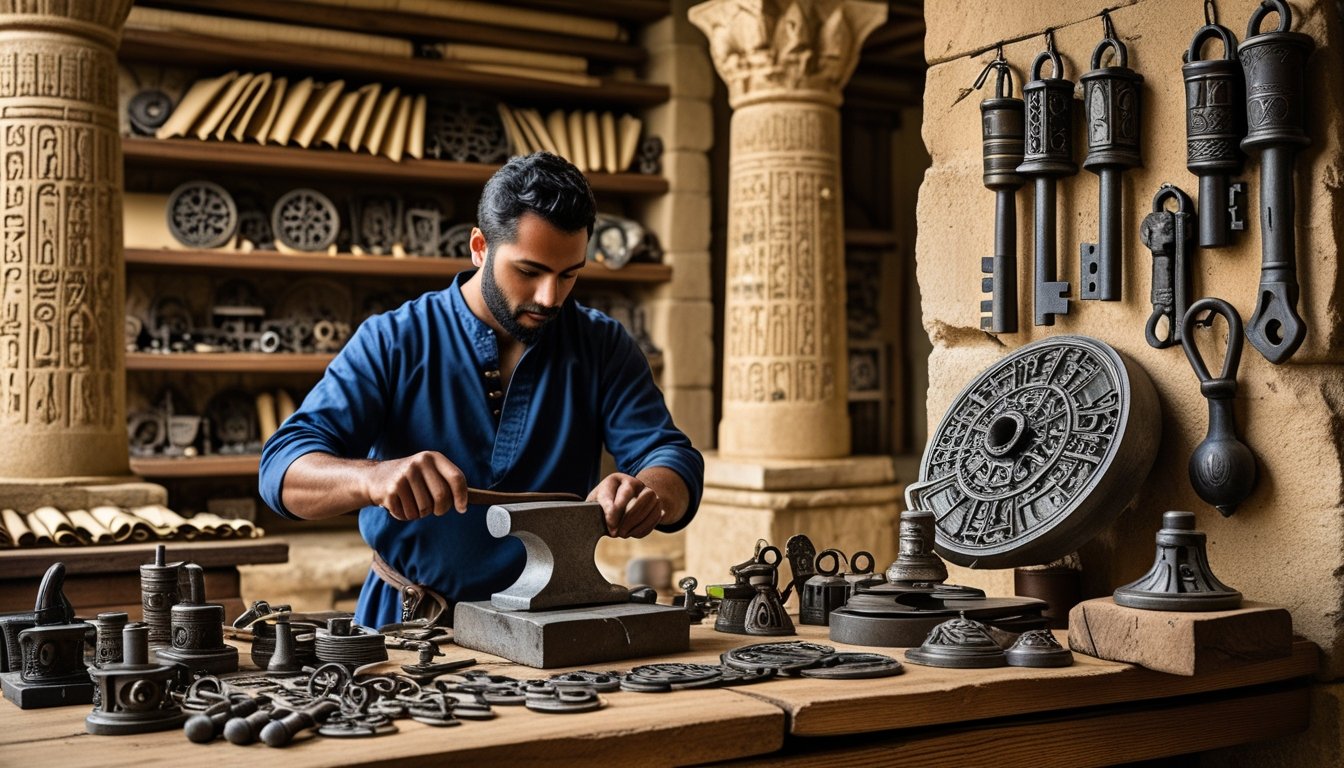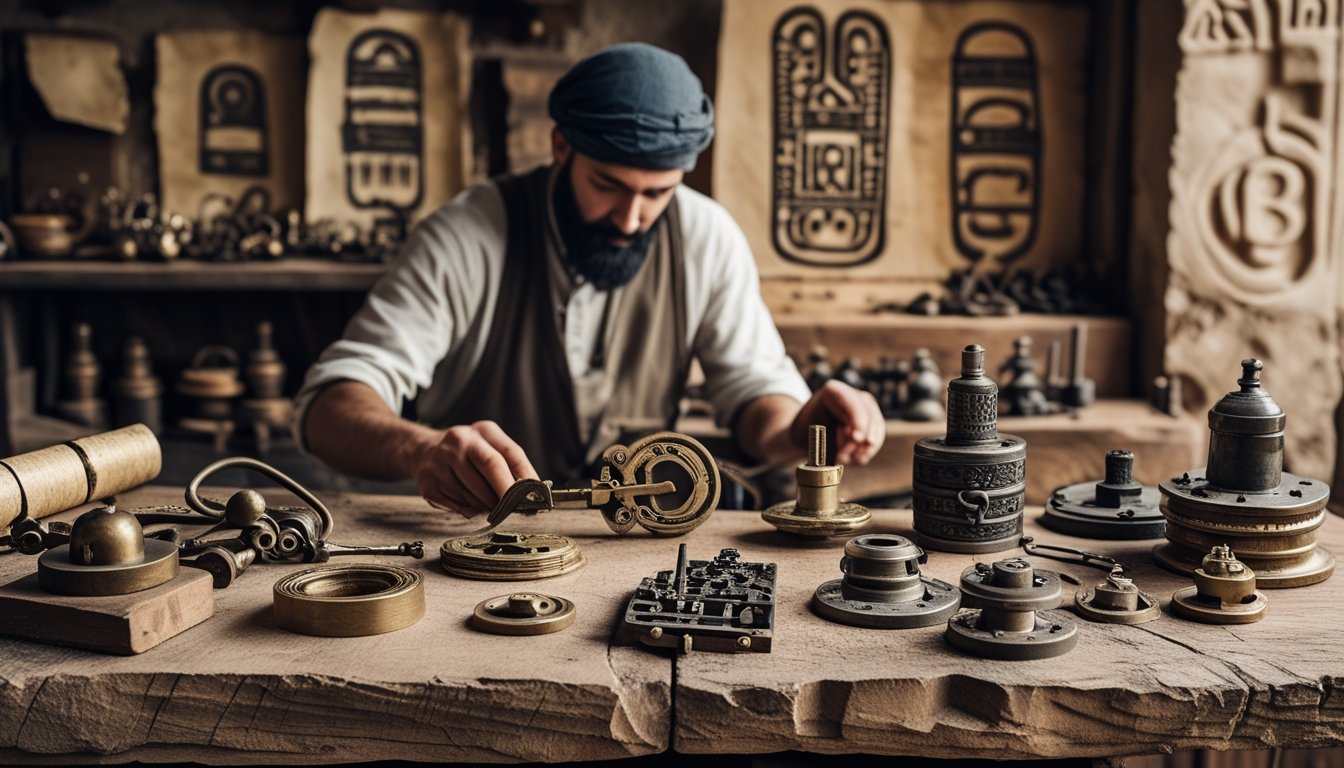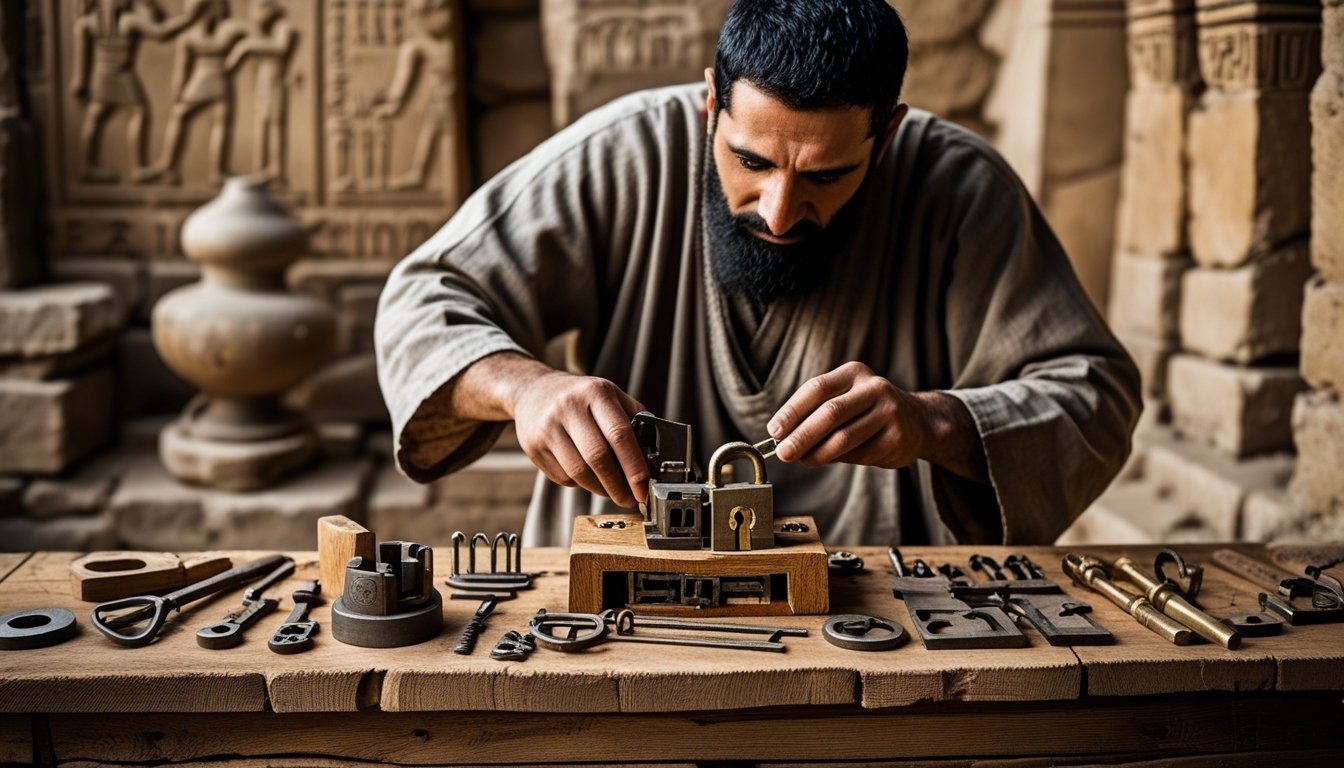Late updated: 02 Sep 2025 10:09
Written by: Elena Prescott
History Of Locksmithing In Ancient Civilisations: A Comprehensive Overview
The story of locksmithing stretches back thousands of years, deeply intertwined with the very fabric of ancient civilisations. As these early societies sought to protect their treasured belongings and maintain security, they developed rudimentary locks and keys. Locksmithing is believed to have originated in Ancient Egypt, where evidence of the first wooden locks and keys has been unearthed in the ruins of the Pharaohs' tombs. This reflects not only the drive for security but also the incredible ingenuity of these early craftsmen.

As we explore the evolution of locksmithing, we can see how the craft evolved from simple wooden devices to more intricate mechanisms. The advancement of this trade continued through various ancient societies, including Babylon and Rome, where locksmiths became highly esteemed artisans. Their expertise in crafting sophisticated locks was instrumental in safeguarding homes, temples, and treasures.
The rich history of locksmithing is a testament to human innovation and the timeless quest for security. By understanding its ancient origins, we gain insight into how these early practices laid the groundwork for the sophisticated security systems we rely on today. As we continue our exploration, we'll delve deeper into the techniques and challenges faced by these pioneering locksmiths.
Key Takeaways
- Locksmithing originated in ancient civilisations like Egypt.
- Early locksmiths were skilled craftsmen who created intricate locks.
- The craft laid the foundation for modern security systems.
Origins and Evolution of Locksmithing in Ancient Civilisations
We trace locksmithing's journey from the rudimentary locks of Mesopotamia and Egypt to the innovations across ancient civilisations. Each culture contributed unique advancements, laying the groundwork for modern lock systems. Let's explore these developments step by step.
Early Locks and Keys in Mesopotamia and Egypt
The earliest locks appeared over 4,000 years ago in Mesopotamia and Egypt. These were basic wooden devices intended to secure gates and doors. Egyptian locks, typically made from wood, used a pin tumbler mechanism, which is considered a significant early innovation. When a key was inserted, it lifted pins inside, allowing the bolt to move. This simple yet effective design highlights the ingenuity of ancient craftsmen.
In Mesopotamia, locksmiths crafted similar mechanisms using available materials. These early solutions provided necessary security by preventing unauthorised entry. They relied heavily on creativity with limited resources, ensuring stability and safety in a tumultuous era. The legacy of these early lock-making efforts is foundational, influencing the evolution of locking mechanisms through history.
Wooden Locks and Innovations in Ancient China
Ancient China made significant contributions to locksmithing, particularly evident in their development of wooden locks. During the Zhou Dynasty, Chinese locksmiths refined locking techniques, crafting intricate wooden tumbler locks. These devices demonstrated impressive complexity for their time. Notably, they featured moving parts that interlocked in specific ways, offering enhanced security.
The craftsmanship of Chinese locksmiths set a high standard. Techniques employed were passed down through generations, with each new generation building upon the last. This legacy underscored the importance of security in daily life. The wooden locks of ancient China not only secured doors but also influenced the development of more advanced locking systems over time.
Roman and Greek Advancements in Lock Mechanisms
The Romans and Greeks took locksmithing to new heights, introducing metal as a primary material for locks and keys. Roman locksmiths designed sophisticated metal locks with multiple wards or obstructions within the lock casing that keys had to navigate. Padlocks, a Roman innovation, provided additional portability and security.
Greek craftsmen also made strides with complex tumbler locks, enhancing lock durability and reliability. These advancements highlighted a crucial transition from wooden to metal locks, reflecting the period's technological progress. The impact of Roman and Greek contributions is unmistakable, as these innovations laid essential groundwork for the locks we use today. Their work emphasised the evolving need for secure lock systems as civilisations continued to grow and prosper.
Lock-Picking, Security, and the Rise of the Locksmith’s Craft

The evolution of locksmithing has always intertwined with security and the art of lock-picking. From early societies employing primitive methods to bypass locks, to the refined skills of ancient locksmiths, the journey highlights the drive to create secure systems and solve problems like lost keys.
Lock-Picking Practices in Early Societies
Lock-picking has long been part of human innovation, driven by the quest to open what should remain closed. In ancient Egypt and Mesopotamia, where locks were essentially wooden bolts with keyholes, the lock-pick emerged as a tool for those seeking to manipulate these devices. This practice wasn't limited to nefarious purposes; it also facilitated understanding of lock mechanisms for improvement.
Roman times saw a more sophisticated approach as metal locks became prevalent. Crafty individuals developed skills to manoeuvre within locks, setting the stage for locksport, the sport of opening locks. These early lock-picking endeavours laid down the foundations for ongoing enhancements in security systems, pushing locksmiths to innovate.
The Emergence and Role of the Ancient Locksmith
As locks became more intricate, so did the necessity for skilled craftsmen. Ancient locksmiths were artisans who crafted security mechanisms combining both functionality and aesthetic value. They were revered in societies like the Greeks and Romans, where metalworking skills enabled more complex and reliable locks.
These locksmiths not only created locks but also innovated solutions for challenges like "unpickable locks." By combining knowledge of metallurgy with inventive design, they responded to ever-evolving security threats. The trust placed in locksmiths was immense, given their role in safeguarding possessions and secrets. Their expertise propelled locksmithing from a basic trade to a respected craft.
Influence of Security Concerns on Lock Design
Security concerns have always driven innovations in lock design. In ancient times, the threat of intrusions prompted locksmiths to enhance lock complexity. The increase in the intricacy of mechanisms mirrored societal demands for better security solutions. This demand extended to ensuring what was thought of as perfect security.
Metal mechanisms began replacing wooden locks, and locksmiths experimented with pin tumblers and wards. Such advancements tackled the challenge of making locks more secure against unauthorised access. Kit-locks, which needed specific skills to open without keys, reflected an evolving understanding of locks as barriers against both physical and intellectual intrusions.
Lost Keys and Early Solutions
Losing keys has troubled humans since ancient times, prompting innovative solutions from locksmiths. Originally, losing a wooden key might not have had dire consequences due to basic lock simplicity. As key designs grew more complex, so did the impact of a misplaced key.
Locksmiths developed solutions such as the master key, which could open multiple locks. The skeleton key, a tool capable of bypassing various locks, was another innovation, though not without risks. This adaptability demonstrated locksmiths' response to practical challenges. We can see here how the balance between accessibility and security became a key theme in the evolution of early locksmithing practice.
Frequently Asked Questions

Locksmithing in ancient civilisations was profoundly influenced by several cultures, each contributing unique advancements. Ancient locks and keys evolved through varied techniques and materials, reflecting the craftsmanship and social status of locksmiths.
How did ancient civilisations contribute to the development of locksmithing?
Ancient civilisations such as Egypt, Greece, and Rome were instrumental in advancing locksmithing. They developed some of the earliest known locking mechanisms. These societies laid the groundwork for future innovations by refining design and functionality.
What were the primary lock mechanisms used in ancient times?
In ancient times, pin tumbler locks, warded locks, and wooden mechanisms were commonly used. Egyptian locks often had wooden pin tumbler systems, while Roman locksmiths crafted intricate warded locks to prevent unauthorised access.
In which civilisation did the concept of locksmithing first appear?
The art of locksmithing is believed to have first appeared in ancient Egypt and Babylon. These cultures pioneered the creation of simple yet effective locks, setting the stage for technological advancements in security.
Can you explain the progression of lock-making techniques through different ancient civilisations?
Lock-making techniques progressed from basic wooden locks used by the Egyptians to more sophisticated metal locks crafted by the Greeks and Romans. Each civilisation improved upon earlier designs, incorporating new materials and methods to enhance security.
What materials were commonly used by ancient cultures for manufacturing locks and keys?
Ancient cultures employed a variety of materials including wood, iron, and brass. Egyptian locks often utilised wood, whereas Greek and Roman locks transitioned to metal. The choice of material impacted durability and complexity.
How did the social status of locksmiths vary among ancient societies?
The social status of locksmiths varied significantly among ancient societies. In Rome and Greece, locksmiths were regarded as skilled craftsmen with special expertise. In contrast, in other cultures, they might have held a more modest standing.
